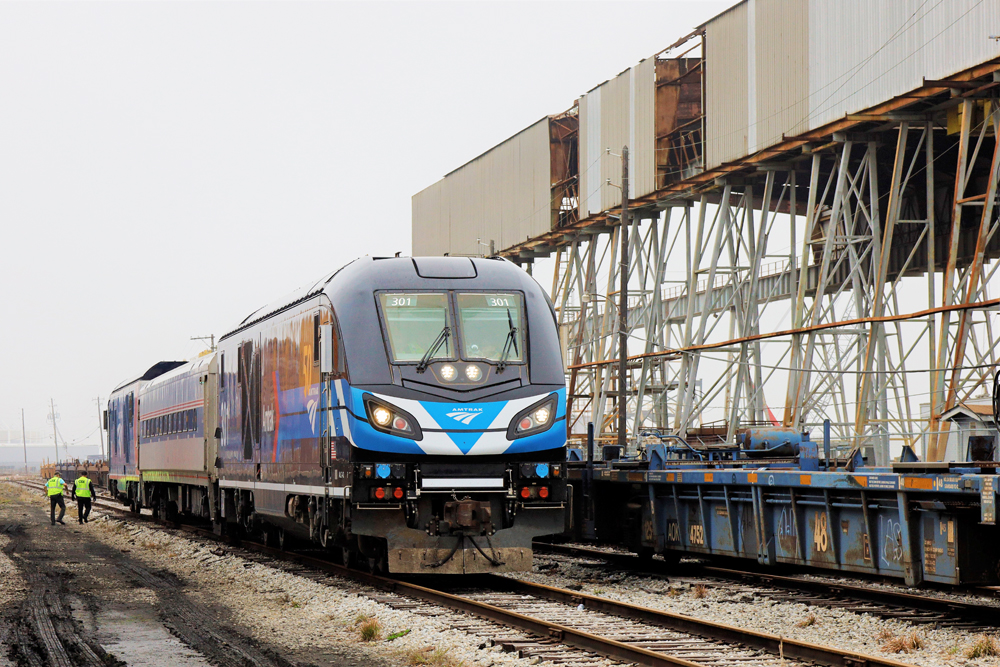 ROME, Ga. — No injuries were reported in a complex incident Saturday involving Norfolk Southern trains in the towns of Rome and Lindale, Ga.
ROME, Ga. — No injuries were reported in a complex incident Saturday involving Norfolk Southern trains in the towns of Rome and Lindale, Ga.
NS spokesman Connor Spielmaker said in a statement that early Saturday, “two cars from a train derailed and a passing train struck them. That train was unable to immediately stop and struck the front of another train further ahead which was not occupied at the time.
“We’d like to thank the local authorities who responded and checked out our crew. Our personnel are on-site and working quickly to restore service and clean up. We appreciate the community’s patience during this work.”
The Northwest Georgia News website reports the incident was first reported to authorities about 4:15 a.m., and led to a diesel fuel spill at one of the collision sites. There were no other hazardous-material or environmental issues.
A number of streets were closed throughout Saturday while the incident was cleaned up.














https://www.youtube.com/watch?v=ULEU_lvXZ3M
Looking at the video the lead unit brake system is severely damaged on the firemans side. The locomotive probably did go into emergency but the damage prevented the brakes from applying. Even if the crew managed to turn the handbrake wheel it appears that it was no longer connected to the brakes. With the locomotive in emergency they would have been unable to use dynamic braking.
Raking side collision with loaded coal hoppers throws coal onto the nose of the breakaway Gevo lead unit, and the head on collision throws that coal onto the nose of the dash-9 many miles down the line.
Well, I cannot imagine what happened in this particular case, but the thing to keep in mind is that locomotive brakes are applied by the presence of air pressure, therefore, if there were just the right type and amount of damage to the lead locomotive’s independent brake system, like the main reservoir or the air compressor, there could be the condition where there is no air pressure to apply the locomotive’s brakes and if it was separated from the train, there would only be the hand brake or dynamic brake. Someone mentioned earlier the hand brake was or could have been damaged from the collision with the coal cars.
These systems sure are complicated, even though I have been interested in railroading since I could crawl I am glad I am not a locomotive engineer. Almost everybody including a lot of management does not understand how dangerous a job being a locomotive engineer is.
“I would think that PTC would have sent a confirmatory message to the crew, before any drastic action took place and thus avoid this accident. ”
Andrew Chandler:
It al depends on how close you are to the signal when it drops as to whether the God Box gives you enough warning to do something. If the signal drops on the approaching train and it is too close to stop before the signal (As in an absolute signal as opposed to an intermediate signal) the God Box will just dump your air with little or no warning as all it “sees” is a red absolute. One of the more common misfires we have with PTC is when the system loses communication with a switch or a signal. I had one a couple weeks back (one of several over the past 3yrs) where I passed underneath a clear intermediate signal and the God Box chirped 3 times put up a “signal status unknown” banner and gave me a penalty ( as opposed to an emergency application) all in a matter of under a second. I didnt even have time to take my eyes from the windshield to the screen to see what the chirp was before it took my air.
I thought PTC was supposed to prevent accidents… not cause them!
Very interesting!! Boy will really like to see the accident report. So many questions. Is the scuttlebutt correct ? If so. The big question is why could the crew of the runaway loco not stop it? Did loco indepent bail off happen and could not be restored? Was runaway still providing traction power? Would loco not go into reverse? Was there loco cab damage? could main breaker not be pulled or was it? would loco not go into reverse? Was loco free rolling down hill? Speed of head on? Was parked train manned and if so did they bail when warned of a run away? Fatique? Experience?
Additional questions. could parted MU cable have caused problems? What is the effect on locos with the 3 air hoses parted to atmosphere?
Imagine you are rolling along in the intermodal locomotive, passing an opposite direction coal train, it is 4:00am… now the adjacent train goes into emergency and dumps a couple of coal hoppers onto your track or into your unit.
Even presuming all concerned were fully awake and aware, that is a pretty startling experience. More so if subsequently it seems that your unit is still on the track, but no longer attached to the rest of your train, and the brakes don’t seem to work.
Fortunately no fatalities. The investigation and report of this should be interesting.
This does not make any sense. If a train suffers a “pull apart” the air hoses separate and the train and engine go into emergency. In addition, locomotives have manual hand brakes. Turn the wheel to apply or press a button to apply? Something is missing.
Donald; the manual handbrake on the BNSF leader on the intermodal is located on the left rear side of the engine. This is where at least one of the derailing coal hoppers impacted the locomotive. Because of the damage, the handbrake would not have been accessible to the crew. As to why the lead engine did not go into emergency; as noted in my earlier post, the brake system on the locomotive was damaged and rendered inoperable by the collision.
Is it me, more reporting, or some other gremlin, there seem to be more railroad accidents lately. Any thoughts?
So if I read this properly, PTC caused this accident. Could not the crew have stopped the train in safe manner, at the start of the incident. I would think the crew would be better address the the signal indication. I would think that PTC would have sent a confirmatory message to the crew, before any drastic action took place and thus avoid this accident. We are fortunate nothing worse occurred.
Andrew you have said it perfectly. PTC can’t see what the engineer sees. In such a situation the rules always stated bring your train to a safe stop using proper train handling. Put it in emergency only if the situation dictates that. It’s that way for the very reason this derailment allegedly happened. The engineer has a proceed signal and it drops. He sees there is nothing ahead requiring an emergency brake application and brings his train safely to a stop. Granted probably a bit quicker than normal. All PTC sees is a red signal and nothing else. There’s nothing the engineer can do. Now, imagine if the passing train had been a passenger train.
Here is the crew room water cooler scuttlebutt.
A southbound coal train experienced a momentary signal drop. PTC responded by throwing the train into emergency. This caused two coal hoppers to derail into the lead locomotive on a northbound intermodal train. The impact broke the rear knuckle on the intermodal train’s lead locomotive and rendered its brakes inoperable. The lone engine continued north for about six miles before running head on into the locomotive of a parked southbound train. The crew on the runaway loco bailed off before impact with the conductor sustaining non-life threatening injuries.
There are some fuzzy details here that I hope will be clarified later.